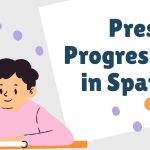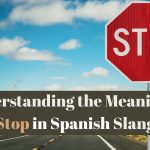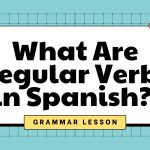The Spanish Present Perfect, or ‘el pretérito perfecto’, is a useful way to link the past with the present. It combines the auxiliary verb ‘haber’ with a past participle. This structure is especially good for talking about recent events or significant changes that still affect us now. This raises some cool questions. How does this affect the way we talk in real life? What can it tell us about how different cultures view time and memory?
So, when we compare this tense to how we express similar ideas in English, we start to see some clear differences and similarities. This insight can help us understand each other better, especially in multicultural settings. What do you think? How do these nuances in language shape our perception of events and our memories?
What is the present perfect tense in Spanish?
The present perfect tense in Spanish, or ‘el pretérito perfecto,’ helps talk about past actions that still matter now.
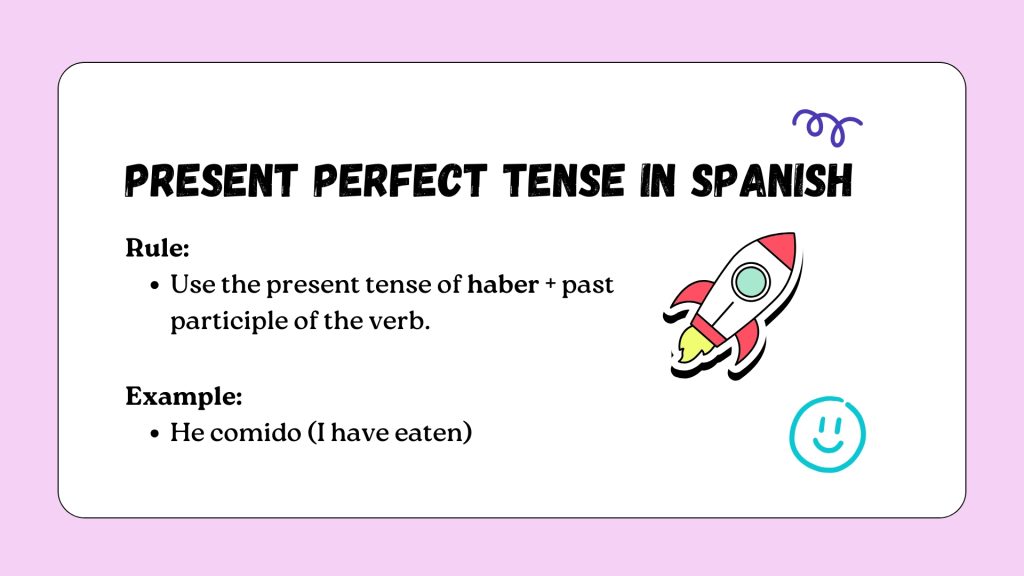
It’s good for sharing experiences or big changes over time without focusing on when exactly they happened.
Rules:
- Use the present tense of haber + past participle of the verb.
| Subject | Haber (present tense) |
|---|---|
| Yo | he |
| Tú | has |
| Él/Ella/Usted | ha |
| Nosotros/as | hemos |
| Vosotros/as | habéis |
| Ellos/Ellas/Ustedes | han |
Examples:
- He comido (I have eaten)
- Has llegado tarde (You have arrived late)
- Han terminado el trabajo (They have finished the work)
How to form the Spanish present perfect?
Understanding the Spanish present perfect isn’t too tricky.
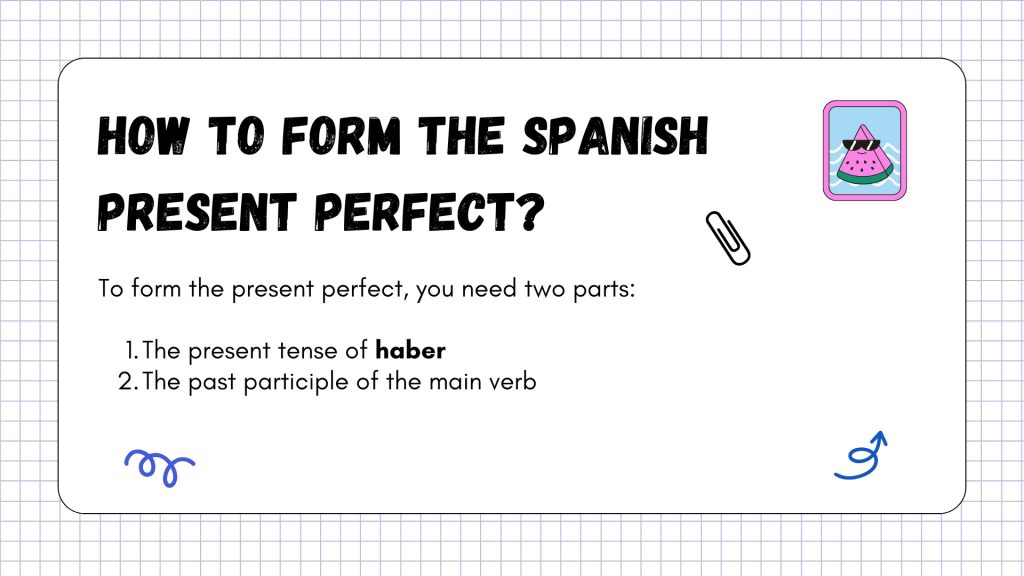
To form the present perfect, you need two parts:
- The present tense of haber
- The past participle of the main verb
Step 1: Present Tense of Haber
| Subject | Conjugation |
|---|---|
| Yo | he |
| Tú | has |
| Él/Ella/Usted | ha |
| Nosotros/as | hemos |
| Vosotros/as | habéis |
| Ellos/Ellas/Ustedes | han |
Step 2: Past Participle Formation
| Verb Type | Ending | Example | Past Participle |
|---|---|---|---|
| -AR | -ado | hablar | hablado |
| -ER | -ido | comer | comido |
| -IR | -ido | vivir | vivido |
Irregular Past Participles:
| Verb | Past Participle |
|---|---|
| abrir | abierto |
| decir | dicho |
| escribir | escrito |
| hacer | hecho |
| poner | puesto |
| romper | roto |
| ver | visto |
| volver | vuelto |
Explore more rare gems in our full list of Spanish Words That Start With K .
How to use the present perfect subjunctive?
To grasp the present perfect subjunctive in Spanish, you need to get the hang of both its mood and its aspect. This tense helps you talk about doubts, wishes, or uncertainties regarding past events that might still matter now.
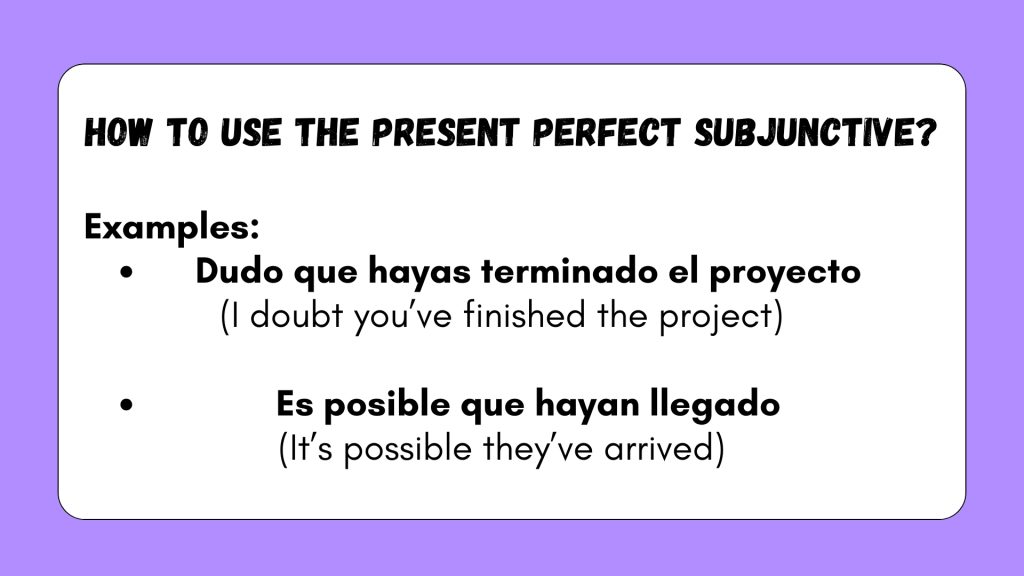
Conjugation of Haber (Subjunctive Form):
| Subject | Haber (subjunctive) |
|---|---|
| Yo | haya |
| Tú | hayas |
| Él/Ella/Usted | haya |
| Nosotros/as | hayamos |
| Vosotros/as | hayáis |
| Ellos/Ellas/Ustedes | hayan |
Examples:
- Dudo que hayas terminado el proyecto (I doubt you’ve finished the project)
- Es posible que hayan llegado (It’s possible they’ve arrived)
- Me alegra que lo hayas hecho (I’m glad you did it)
What are the time markers of the present perfect?
After talking about how the present perfect subjunctive feels and works, let’s look at the clues that show when to use the present perfect tense in Spanish.
These words help point out actions that are connected to now or the very recent past.
| Time Marker | Meaning |
|---|---|
| hoy | today |
| esta semana | this week |
| este mes | this month |
| este año | this year |
| últimamente | lately |
| ya | already |
| todavía | still/yet |
| alguna vez | ever |
| nunca | never |
| recientemente | recently |
Examples:
- Ya he terminado (I have already finished)
- ¿Alguna vez has viajado a México? (Have you ever traveled to Mexico?)
- Esta semana hemos trabajado mucho (This week we’ve worked a lot)
Commonly Used Verbs In Present Perfect Tense
In Spanish, we often use the present perfect tense to talk about things that happened before but still matter now. Some common verbs in this tense are ‘haber’, ‘tener’, ‘hacer’, ‘decir’, ‘estar’, and ‘ir’.
| Verb | Past Participle | Example |
|---|---|---|
| hacer | hecho | He hecho mi tarea |
| decir | dicho | Has dicho la verdad |
| ver | visto | Hemos visto esa película |
| escribir | escrito | Ella ha escrito una carta |
| poner | puesto | Han puesto la mesa |
| volver | vuelto | He vuelto temprano |
| romper | roto | Has roto la ventana |
| abrir | abierto | Hemos abierto el paquete |
| leer | leído | Has leído el libro |
| vivir | vivido | He vivido en Chile |
Find out which rare Spanish words begin with the tricky letter X.
Examples of present perfect tense in Spanish
Let’s talk about the Spanish present perfect tense.
Take the sentence: ‘I have visited the museum three times this year.’ It shows how the tense is used for actions that happened recently but doesn’t specify when.
These examples help us understand how the tense captures ongoing or recent experiences without focusing on their exact timing.
| Spanish Sentence | English Translation |
|---|---|
| He visitado Barcelona | I have visited Barcelona |
| ¿Has probado la paella? | Have you tried paella? |
| Han escrito muchas cartas | They have written many letters |
| Hemos ido al médico esta semana | We’ve gone to the doctor this week |
| Ella ha ganado el concurso | She has won the contest |
| ¿Has hablado con tu jefe hoy? | Have you spoken to your boss today? |
| No hemos terminado el proyecto | We haven’t finished the project |
| He vivido aquí desde enero | I’ve lived here since January |
| Mis amigos han llegado ya | My friends have already arrived |
| ¿Nunca has visto eso antes? | Have you never seen that before? |
Present Perfect v/s Simple Past
To really get good at Spanish, it’s key to know when to use the present perfect and when to go with the simple past.

The present perfect helps you talk about things that are still connected to now or that happened recently.
On the other hand, use the simple past for things that happened at a specific time and are done and dusted.
Rule of Thumb:
- Present perfect: Use it when time is not specific or still ongoing
- Simple past: Use it when time is clear and finished
| Situation | Present Perfect (He…) | Simple Past (Yo…) |
|---|---|---|
| Visited Madrid | He visitado Madrid | Visité Madrid |
| Saw a movie | Has visto esa película | Viste esa película |
| Finished the report | Hemos terminado el informe | Terminamos el informe |
| Traveled to Peru | Ha viajado a Perú | Viajó a Perú |
| Spoke to the teacher | Han hablado con el profesor | Hablaron con el profesor |
Conclusion
The Spanish Present Perfect tense, or ‘el pretérito perfecto,’ is really useful. It connects past actions to the present.
Here’s how it works: you use the helper verb ‘haber’ and add the main verb’s past participle. This lets you talk about past experiences or things that happened before but still matter now.
Say goodbye to stage fear with Lingua Viva expert coaching.
Carolina is a charming and lively member of Lingua Viva with 11+ years of teaching experience. She loves to teach students appropriate ways to communicate effectively in Spanish without the fear of making mistakes. She holds a professional teaching license and has a graduate degree with emphasis in Foreign Language.


